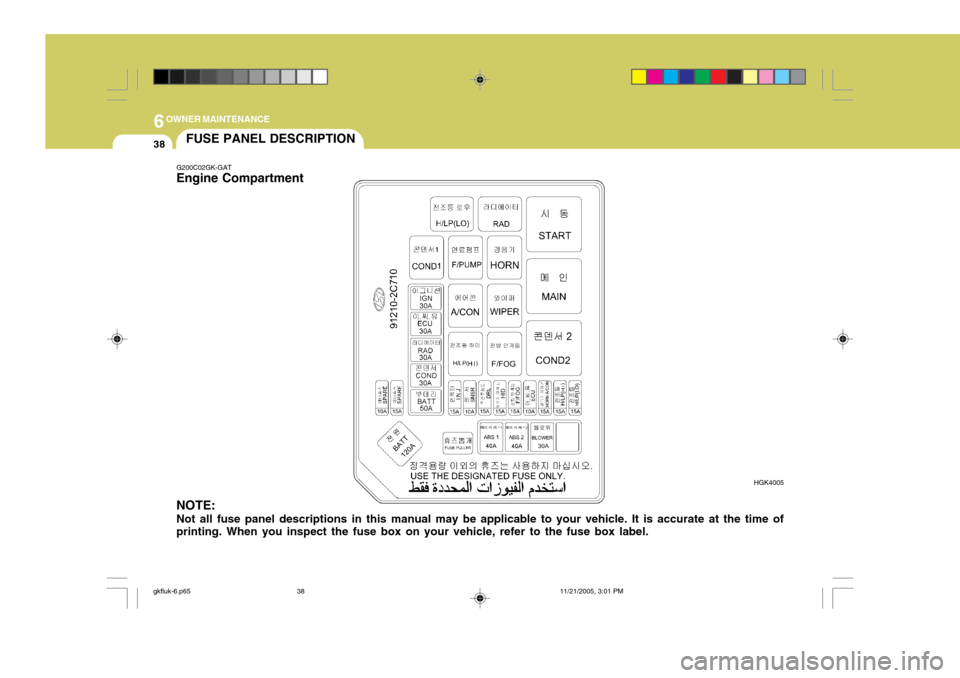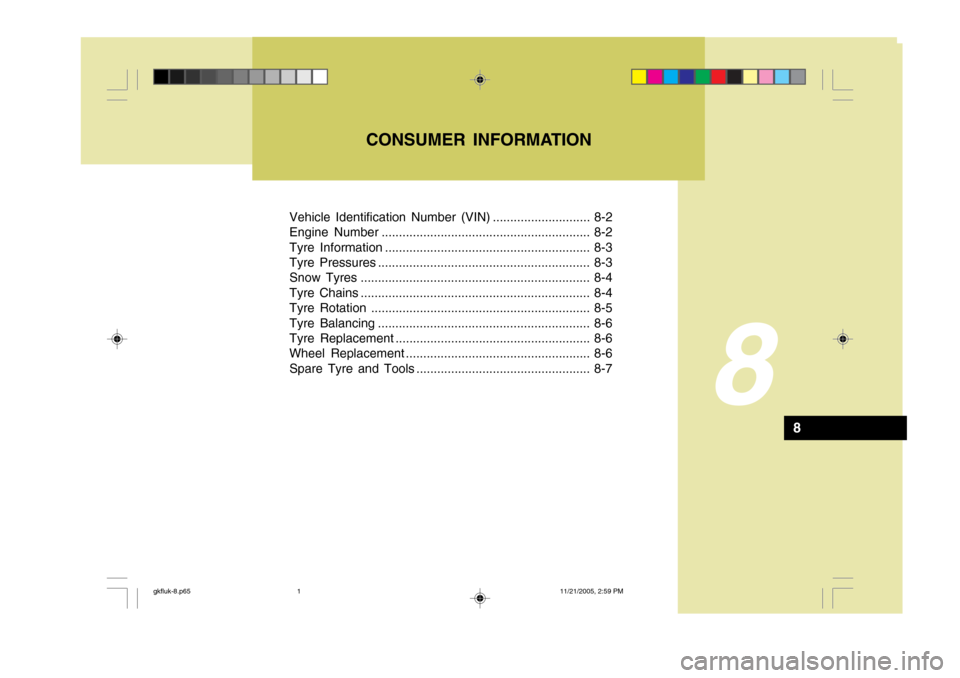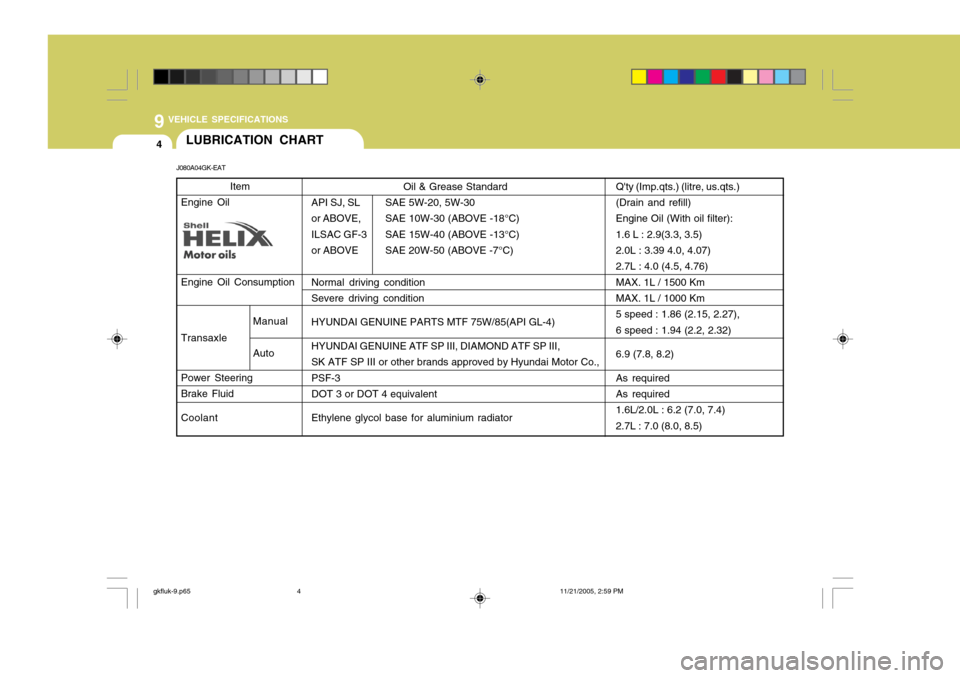engine Hyundai Coupe 2005 Owner's Manual
[x] Cancel search | Manufacturer: HYUNDAI, Model Year: 2005, Model line: Coupe, Model: Hyundai Coupe 2005Pages: 478, PDF Size: 13.44 MB
Page 456 of 478

6OWNER MAINTENANCE
38FUSE PANEL DESCRIPTION
G200C02GK-GAT
Engine Compartment NOTE: Not all fuse panel descriptions in this manual may be applicable to your vehicle. It is accurate at the time of printing. When you inspect the fuse box on your vehicle, refer to the fuse box label. HGK4005
gkfluk-6.p65
11/21/2005, 3:01 PM
38
Page 457 of 478

6
OWNER MAINTENANCE
39
PROTECTED COMPONENTS
Generator(1.6L/2.0L) BCM BOX(Tail lamp relay,Power connector,Fuse(2,7,12,13,19,20,24))Condenser fan relayRadiator fan relayEngine control relay, Fuel pump relay, A/T control relay, Generator,ECM(1.6L/2.7L),PCM(2.0L) Ignition switch,Start relayABS/ESP control module,ESP Air bleeding connectorABS/ESP control module,ESP Air bleeding connectorBlower relayInjector Oxygen sensor,Camshaft position sensor, Idle speed control actuator DRL control moduleFront fog lamp relayTCM(2.7L),ECM(2.7L/1.6L)Horn relay,A/C relay Head lamp relay(High) Head lamp relay(Low)
FUSERATING 120A50A 30A30A 30A 30A 40A40A30A 15A 10A15A15A10A15A 15A 15A
DESCRIPTION
BATTBATT
COND RAD ECU
IGN
ABS 1 ABS 2
BLOWER INJ
SNSR DRL
F/FOG ECU
HORN,A/CON H/LP (HI)
H/LP (LO)
gkfluk-6.p65 11/21/2005, 3:01 PM
39
Page 461 of 478

7EMISSION CONTROL SYSTEMS
2
SH010A1-E (Not all models) Depending upon the market for which the vehicle is destined, the emission control system will comprise one or more of the following emission controldevices.
(1) Crankcase emission control sys-
tem
(2) Evaporative emission control sys- tem
(3) Exhaust emission control systemIn order that the proper functioning of the emission control systems may be ensured, it is recommended that the vehicle is inspected and maintainedby a Hyundai authorised repairer in accordance with the maintenance schedule in this manual. EMISSION CONTROL SYS- TEMS
SH010B1-E
1. CRANKCASE EMISSION CON- TROL SYSTEM The positive crankcase ventilation system is employed to prevent air pollution caused by blow-by gases being emitted from the crankcase byintroducing fresh air to the crankcase through the air cleaner where this mixes with blow-by gases and thenpasses through the PCV valve into the intake manifold from where it sub- sequently enters the combustionchamber and is burned.
SH010C1-E
2. EVAPORATIVE EMISSION
CONTROL SYSTEM
The Evaporative Emission Control
System is designed to prevent fuelvapours from escaping into the atmo-sphere through the fuel tank ventila- tion system. SH010D1-E
3. EXHAUST EMISSION
CONTROL SYSTEM
The exhaust emission control system
is a highly effective system which controls exhaust emission while main- taining good vehicle performance. Whilst the engine is not running, fuel vapours generated inside the fuel tankare absorbed and stored in a char- coal canister. When the engine is started, the vapours stored in thecanister are drawn into the induction system through the purge control so- lenoid valve and are subsequentlyburned.The purge control solenoid valve iscontrolled by the ECU; when the en-gine coolant temperature is low or the engine is idling, the purge control valve is closed and fuel vapours re-main stored in the canister. Under normal running conditions when the engine is warm, the valve opens andthe vapours are drawn into the inlet tract and subsequently burned in the combustion chamber.
gkfluk-7.p65
11/21/2005, 3:00 PM
2
Page 462 of 478

7
EMISSION CONTROL SYSTEMS
3CATALYTIC CONVERTOR
SH020A1-E Hyundai Coupe models are fitted with catalytic convertors which requirespecial operating considerations. The catalytic convertor serves to oxidize certain noxious elements of the ex-haust gases leaving the engine to reduce the level of pollutants emitted from the vehicle and, provided thatcare is exercised to prevent damage, the catalyst will operate efficiently for the life of the vehicle. It is of the utmost importance that the following information is read and un- derstood by the vehicle operator inorder to prevent operational problems arising from damage to the catalyst. Damage to the catalyst will result if contamination occurs through the useof leaded fuel. Whilst the vehicle is fitted with a reduced diameter filler neck to prevent charging of the fueltank with a leaded fuel pump nozzle, it is possible that the use of funnels or fuel cans will permit leaded fuel to beintroduced into the fuel tank.The catalyst is intolerant of unburntfuel and therefore if an engine misfirecondition exists, damage to the cata- lyst will occur. It is imperative that if a misfire condition develops, the ve-hicle is immediately presented to a Hyundai authorised repairer for rectifi- cation. Similarly, the practice of cer-tain ignition system diagnosis proce- dures which involve inducing a misfire (cylinder power balance tests for ex-ample) may result in catalyst damage.For these reasons, it is advisable thatthe exhaust gas emission be tested at each routine service with a gas analyzer having a Hydrocarbon mea-suring facility to ensure continued re- liability of the catalyst.
Catalytic Converter
HGK5061 Push or tow starting of the vehicle is to be avoided since unburnt fuel mayenter the catalyst and result in dam- age. (Note, it is impossible to push or tow start a Hyundai model equippedwith fuel injection since the fuel pump safety interlock will prevent the pump from operating under these conditions). Operation of the catalyst involves ex- tremely high temperatures being at- tained within the catalytic convertor,and although the convertor is fitted with heat shields, it is important that the vehicle is not parked over combus-tible or volatile material which may result in fire. If the above precautions are not ad- hered to and the catalyst becomes inoperative, the resultant increase incore temperature will result in a "melt down" where the catalyst core will melt and subsequently may block theexhaust system.Due to the fragile nature of the cata-lyst element, it is important that dam-age does not occur when the vehicle is raised by means of a garage jack. Care must also be exercised to avoiddriving over road hazards or debris which may cause damage to the cata- lyst element.
gkfluk-7.p65
11/21/2005, 3:00 PM
3
Page 463 of 478

Vehicle Identification Number (VIN) ............................ 8-2
Engine Number ............................................................ 8-2
Tyre Information ........................................................... 8-3
Tyre Pressures ............................................................. 8-3
Snow Tyres .................................................................. 8-4
Tyre Chains .................................................................. 8-4
Tyre Rotation ............................................................... 8-5
Tyre Balancing ............................................................. 8-6
Tyre Replacement ........................................................ 8-6
Wheel Replacement ..................................................... 8-6
Spare Tyre and Tools .................................................. 8-7
8
CONSUMER INFORMATION
8
gkfluk-8.p6511/21/2005, 2:59 PM
1
Page 464 of 478

8CONSUMER INFORMATION
2
F040A02TB-1
1.6LHGK220
SI010A1-E
VEHICLE IDENTIFICATION NUMBER (VIN)
The vehicle identification number (VIN) is unique to each individual vehicle and is the number (some-times referred to as chassis number) used upon the vehicle registration document to identify the vehicle.The VIN will be found stamped upona plate attached to the engine bulk-head. SI010B1-E
ENGINE NUMBER
The engine number is stamped onthe engine block as shown in the drawing.I010B01B
2.7L
HFO6003
2.0L
gkfluk-8.p65
11/21/2005, 2:59 PM
2
Page 470 of 478

Measurement................................................................ 9-2
Engine ........................................................................... 9-3
Lubrication Chart .......................................................... 9-4
9
VEHICLE SPECIFICATIONS
9
gkfluk-9.p65 11/21/2005, 2:59 PM
1
Page 472 of 478

9
VEHICLE SPECIFICATIONS
3
2.0 L
82 x 93.5 1,975
1 - 3 - 4 - 2
0.0067 ~ 0.0091 in. (0.17 ~ 0.23 mm) 0.0098 ~ 0.0122 in. (0.25 ~ 0.31 mm)
0.0047 ~ 0.011 in. (0.12 ~ 0.28 mm) 0.0079 ~ 0.015 in. (0.2 ~ 0.38 mm)
700 ± 100
BTDC 8° ± 5° 2.7 L
6-Cyl., V-type DOHC 86.7 x 75
2,656
1 - 2 - 3 - 4 - 5 - 6
AUTO LASH
750 ± 100
BTDC 12° ± 10°
4-Cyl., In-line DOHC
1.6 L
76.5 x 87 1,599
1 - 3 - 4 - 2
AUTO LASH
700 ± 100
BTDC 5° ± 5°
ITEMS
Engine TypeBore x Stroke (mm) Displacement (cc) Firing order Valve clearance (Cold Engine 20 ± 5°C) Idle speed (rpm) Ignition timing (Base)
For adjustingFor checking Intake ExhaustIntake Exhaust
ENGINE
J070A05GK-EAT SPECIFICATION
gkfluk-9.p65 11/21/2005, 2:59 PM
3
Page 473 of 478

9 VEHICLE SPECIFICATIONS
4
Q'ty (Imp.qts.) (litre, us.qts.) (Drain and refill) Engine Oil (With oil filter):1.6 L : 2.9(3.3, 3.5) 2.0L : 3.39 4.0, 4.07) 2.7L : 4.0 (4.5, 4.76)MAX. 1L / 1500 Km MAX. 1L / 1000 Km 5 speed : 1.86 (2.15, 2.27),6 speed : 1.94 (2.2, 2.32) 6.9 (7.8, 8.2)As required As required 1.6L/2.0L : 6.2 (7.0, 7.4)2.7L : 7.0 (8.0, 8.5)
LUBRICATION CHART
J080A04GK-EAT Oil & Grease Standard
API SJ, SL SAE 5W-20, 5W-30
or ABOVE, SAE 10W-30 (ABOVE -18°C)
ILSAC GF-3 SAE 15W-40 (ABOVE -13°C)
or ABOVE SAE 20W-50 (ABOVE -7°C) Normal driving condition Severe driving condition HYUNDAI GENUINE PARTS MTF 75W/85(API GL-4)HYUNDAI GENUINE ATF SP III, DIAMOND ATF SP III, SK ATF SP III or other brands approved by Hyundai Motor Co.,PSF-3 DOT 3 or DOT 4 equivalent Ethylene glycol base for aluminium radiator
Item
Engine Oil Engine Oil Consumption Transaxle Power Steering Brake Fluid Coolant
Manual Auto
gkfluk-9.p65 11/21/2005, 2:59 PM
4
Page 475 of 478

10INDEX
2
A Air bag ....................................................................... 1-30
Air conditioning switch .............................................. 1-82
Air conditioning system mai ntenance .........................6-20
Antenna ...................................................................... 1-96
Anti-lock brake system (ABS) .................................... 2-13
Audio remote control switch .......................................1-73
Automatic transaxle lubricant .....................................6-16
Automatic transaxle ..................................................... 2-8
B
Battery maintenance ................................................... 6-26
Before folding the rear seats ...................................... 1-17
Before starting the engine ........................................... 2-3
Bonnet release ............................................................ 1-65
Brake pedal freeplay ................................................... 6-23
Brake system checking .............................................. 6-18
C Care of cassette tape ............................................... 1-95
Care of disc .............................................................. 1-94
Care of seat belts ..................................................... 1-20
Catalytic convertor ...................................................... 7-3
Central door lock ......................................................... 1-7
Changing a flat type ................................................... 3-6
Changing the air cleaner filter ..................................... 6-12
Checking the clutch fluid ............................................ 6-19Child restra
int system ................................................. 1-22
Cigar lighter ................................................................ 1-56
Clutch pedal freeplay .................................................. 6-23
Cruise control ............................................................. 1-70
D Daily operating checks ................................................ 6-5
Day/nignt rear view mirror ... .....................................1-63
Defrosting/defogging ................................................. 1-80
Digital clock ................................................................ 1-56
Door locks ................................................................... 1-6
Drink holder ................................................................ 1-57
Drive belts .................................................................. 6-24
Driving for economy ................................................... 2-15
EEffective braking ......................................................... 2-12
Electric cooling f ans ................................................... 6-27
Emission control system s ........................................... 7-2
Engine compartment .................................................... 6-2
Engine coolant checking and replacing ...................... 6-10
Engine coolant temperature guage .............................1-44
Engine oil and filter replacement ................................. 6-8
Engine oil consump tion ............................................... 6-7
Engine oil replenishment .............................................. 6-7
Engine oil ..................................................................... 6-5
Exterior rear view mirror ............................................. 1-62
gkfluk-10.p65 11/21/2005, 2:58 PM
2